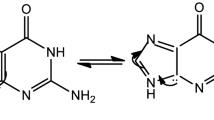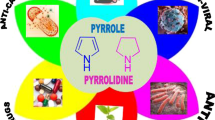Abstract
Two complexes of Zn(II) and Ni(II) ions with the urea derivative, 2-benzimidazolyl-urea (BZIMU), of formulae [ZnBZIMU)2(H2O)](NO3)2 (1) and [Ni(BZIMU)2(CH3CH2OH)2](NO3)2 (2) were synthesized and characterized by their melting point, elemental analysis, spectroscopic techniques (FTIR, UV–Vis and 1H-NMR), High-resolution mass spectroscopy (HRMS), molar conductivity and thermogravimetric analysis. The crystal structures of 1–2 were determined by X-ray diffraction analysis. The antiproliferative activity of 1–2 was tested in vitro against human adenocarcinoma cell lines: cervix (HeLa) and breast (MCF-7). Their toxicity was surveyed against normal human fetal lung fibroblast cells (MRC-5). The bioactivity mechanism of 1–2 and their related analogues of copper and silver metallodrugs are rationalized by the means of computations. The antimicrobial activity of 1–2 against Escherichia coli (E. coli) is also evaluated.
Graphical Abstract
The complexes [ZnBZIMU)2(H2O)](NO3)2 (1) and [Ni(BZIMU)2(CH3CH2OH)2](NO3)2 (2) (BZIMU= 2-Benzimidazolyl-urea), were tested in vitro against HeLa and MCF-7 cells. Their toxicity was surveyed against normal MRC-5 cells. The association of the microbiota with the antiproliferative activity of 1–2 was investigated against Escherichia coli.








Similar content being viewed by others
References
Urbaniak C, Gloor GB, Brackstone M, Scott L, Tangney M, Reid G (2016) The microbiota of breast tissue and its association with breast cancer. Appl Environ Microbiol 82:5039–5048
Mjos KD, Orvig C (2014) Metallodrugs in medicinal inorganic chemistry. Chem Rev 114:4540–4563
Pucci D, Crispini A, Sanz Mendiguchia B, Pirillo S, Ghedini M, Morelli S, De Bartolo L (2013) Improving the bioactivity of Zn(II)-curcumin based complexes. Dalton Trans 42:9679–9687
Zhang Y-P, Mac Z-Y, Gaoa C-Y, Qiaoc X, Tiana J-L, Gua W, Liua X, Xuc J-Y, Zhao J-Z, Yan S-P (2016) Two dpa-based zinc(ii) complexes as potential anticancer agents: nuclease activity, cytotoxicity and apoptosis studies. New J Chem 40:7513–7521
Liguori PF, Valentini A, Palma M, Bellusci A, Bernardini S, Ghedini M, Panno ML, Pettinari C, Marchetti F, Crispini A, Pucci D (2010) Non-classical anticancer agents: synthesis and biological evaluation of zinc(II) heteroleptic complexes. Dalton Trans 39:4205–4212
Frezza M, Hindo S, Chen D, Davenport A, Schmitt S, Tomco D, Dou QP (2010) Novel metals and metal complexes as platforms for cancer therapy. Curr Pharm Des 16:1813–1825
Balakrishnan R, Ramasubbu N, Varughese KI, Parthasarathy R (1997) Crystal structures of the copper and nickel complexes of RNase A: metal-induced interprotein interactions and identification of a novel copper binding motif. Proc Natl Acad Sci USA 94:9620–9625
Aquino NB, Sevigny MB, Sabangan J, Louie MC (2012) The role of cadmium and nickel n estrogen receptor signaling and breast cancer: Metalloestrogens or not? J Environ Sci Health C Environ Carcinog Ecotoxicol Rev. 30:189–224
Razandi M, Pedram A, Levin ER (2000) Plasma membrane estrogen receptors signal to antiapoptosis in breast cancer. Mol Endocrinol 14:1434–1447
Norman AW, Mizwicki MT, Norman DPG (2004) Steroid-hormone rapid actions, membrane eceptors and a conformational ensemble model. Nat Rev Drug Discov 3:27–41
Levenson AS, Jordan VC (1997) MCF-7: the first hormone-responsive breast cancer cell line. Cancer Res 57:3071–3078
Abdel-Mohsen HT, Ragab FAF, Ramla MM, El Diwani HI (2010) Novel benzimidazole–pyrimidine conjugates as potent antitumor agents. Eur J Med Chem 45:2336–2344
Wang W, Kong D, Cheng H, Tan L, Zhang Z, Zhuang X, Long H, Zhou Y, Xu Y, Yang X, Ding K (2014) New benzimidazole-2-urea derivatives as tubulin inhibitors. Bioorg Med Chem Lett 24:4250–4253
Hasegawa M, Nishigaki N, Washio Y, Kano K, Harris PA, Sato H, Mori I, West RI, Shibahara M, Toyoda H, Wang L, Nolte RT, Veal JM, Cheung M (2007) Discovery of novel benzimidazoles as potent inhibitors of TIE-2 and VEGFR-2 tyrosine kinase receptors. Med Chem 50:4453–4470
Perkovic I, Antunovic M, Marijanovic I, Pavic K, Ester K, Kralj M, Vlainic J, Kosalec I, Schols D, Hadjipavlou-Litina D, Pontiki E, Zorc B (2016) Novel urea and bis-urea primaquine derivatives with hydroxyphenyl or halogenphenyl substituents: synthesis and biological evaluation. Eur J Med Chem 124:622–636
Poyraz M, Berber H, Banti CN, Kourkoumelis N, Manos MJ, Hadjikakou SK (2017) Synthesis characterization and biological activity of mixed ligand silver (I) complex of 2-benzimidazolylurea and triphenylphosphine. Polyhedron 128:95–103
Poyraz M, Sari M, Banti CN, Hadjikakou SK (2017) Synthesis, characterization and biological activities of copper (II) complex of 2-benzimidazolyl-urea and the nitrate salt of 2-benzimidazolyl-urea. J Mol Struct 1146:809–813
Poyraz M, Banti CN, Kourkoumelis N, Dokorou V, Manos MJ, Simčič M, Golič-Grdadolnik S, Mavromoustakos T, Giannoulis AD, Verginadis II, Charalabopoulos K, Hadjikakou SK (2011) Synthesis, structural characterization and biological studies of novel mixed ligand Ag(I) complexes with triphenylphosphine and aspirin or salicylic acid. Inorg Chim Acta 375:114–121
Banti CN, Papatriantafyllopoulou C, Manoli M, Tasiopoulos AJ, Hadjikakou SK (2016) Nimesulide silver metallodrugs, containing the mitochondriotropic, triaryl derivatives of pnictogen; anticancer activity against human breast cancer cells. Inorg Chem 55:8681–8696
Poyraz M, Demirayak S, Banti CN, Manos MJ, Kourkoumelis N, Hadjikakou SK (2016) Platinum(II)-thiosemicarbazone drugs override the cell resistance due to glutathione; assessment of heir activity against human adenocarcinoma cells. J Coord Chem 69:3560–3579
Stathopoulou MK, Banti CN, Kourkoumelis N, Hatzidimitriou AG, Kalampounias AG, Hadjikakou SK (2018) Silver complex of salicylic acid and its hydrogel-cream in wound healing chemotherapy. J Inorg Biochem 181:41–55
Milionis I, Banti CN, Sainis I, Raptopoulou CP, Psycharis V, Kourkoumelis N, Hadjikakou SK (2018) Silver ciprofloxacin (CIPAG): a successful combination of chemically modified antibiotic in inorganic-organic hybrid. J Biol Inorg Chem 23:705–723
Xanthopoulou MN, Hadjikakou SK, Hadjiliadis N, Kubicki M, Skoulika S, Bakas T, Baril M, Butler IS (2007) Synthesis, structural characterization, and biological studies of six-and five-coordinate organotin (IV) complexes with the thioamides 2-mercaptobenzothiazole, 5-chloro-2-mercaptobenzothiazole, and 2-mercaptobenzoxazole. Inorg Chem 46:1187–1195
Chrysouli MP, Banti CN, Kourkoumelis N, Panayiotou N, Tasiopoulos AJ, Hadjikakou SK (2018) Chloro (triphenylphosphine) gold(I) a forefront reagent in gold chemistry as apoptotic agent for cancer cells. J Inorg Biochem 179:107–120
Addison WA, Rao TN, Reedijk J, Van Rijn J, Verschoor GC (1984) Synthesis, structure, and spectroscopic properties of copper(II) compounds containing nitrogen–sulphur donor ligands; the crystal and molecular structure of aqua[1,7-bis(N-methylbenzimidazol-2′-yl)-2,6-dithiaheptane]copper(II) perchlorate. J Chem Soc Dalton Trans. https://doi.org/10.1039/DT9840001349
Bhattacharyya S, Kumar SB, Dutta SK, Tiekink ERT, Chaudhury M (1996) Zinc(II) and copper(II) complexes of pentacoordinating (N4S) ligands with flexible pyrazolyl arms: syntheses, structure, and redox and spectroscopic properties. Inorg Chem 35:1967–1973
Lin HC, Huang CC, Shi CH, Liao YH, Chen CC, Lin YC, Liu YH (2007) Synthesis of alkynylated photo-luminescent Zn(II) and Mg(II) Schiff base complexes. Dalton Trans. https://doi.org/10.1039/b615380a
Long LS, Ding KY, Chen XM, Ji LN (2000) A novel dinuclear zinc complex containing both imidazole and carboxylate groups as a possible model for serine/threonine protein phosphatase-1. Inorg Chem Commun 3:65–67
Soroceanu A, Cazacu M, Nistor A, Shova S (2013) Ni(II) and Zn(II) complexes with a salen-type ligand derived from 1,3-bis (3-aminopropyl) tetramethyldisiloxane. Rev Roum Chim 58:209–216
Poyraz M, Sari M, Guney A, Demirci F, Demirayak S, Sahin E (2008) Synthesis, characterization and antimicrobial activity of a Zn(II) complex with 1-(1H-benzoimidazol-2-yl)-ethanone thiosemicarbazone. J Coord Chem 61:3276–3283
Ochs C, Hahn FE, Lügger T (2001) cis-Octahedral nickel(II) complexes with symmetric and unsymmetric tripodal tetraamine ligands. Eur J Inorg Chem 2001:1279–1285
Zasłona H, Drożdżewski P, Ślepokura K (2015) The X-ray structures, vibrational spectroscopy and antimicrobial activity of nickel(II) complexes with 4-hydroxybenzhydrazide. J Mol Struct 21100:34–42
Jana MS, Pramanik AJ, Mondal TK (2014) Octahedral Ni(II) and Cu(II) complexes with a new hexadentate (NSN) 2 donor ligand: Synthesis, characterization, X-ray structure and DFT calculations. Polyhedron 76:29–35
Sari M, Poyaz M, Demirayak S, Buyukgungor O (2005) Crystal structure of [1-(1H-benzoimidazol-2yl-)-ethanone thiosemicarbazone]2 nickel. (C20H22N10S2)Ni. Anal Sci 21:183–184
Nakamoto K (1986) Coordination compounds infrared and raman spectra of inorganic and coordination compounds, 4th edn. Wiley, New York
Chong-de L, Li-juan J, Wen-xia T (1993) Vibrational spectra and normal coordinate analysis for cis-diamminetetrachloroplatinum. Spectrochim Acta A Mol Biomol Spectrosc 49:339–343
Love SP, Huckett SC, Worl LA, Frankcom TM, Ekberg SA, Swanson BI (1993) Far-infrared spectroscopy of halogen-bridged mixed-valence platinum-chain solids: isotope-substitution studies. Phys Rev B 47:11107–11123
Cavalheiro ETG, Lemos FCD, Schpector JZ, Dockal ER (2001) The thermal behaviour of nickel, copper and zinc complexes with the Schiff bases cis-and trans-N, N′-bis (salicylidene)-1, 2-ciclohexadiamine (Salcn). Thermochim Acta 370:129–133
Masoud MS, El-Merghany A, Ramadan AM, Abd El-Kaway MY (2010) Thermal studies of some purine compounds and their metal complexes. J Therm Anal Calorim 101:839–847
Siddiqi KS, Umar A, Nami SAA, Khan S (2006) Synthesis, characterization and spectroscopic studies of the dihydrobis (1, 2, 3-benzotriazolyl) borate anion and its complexes with MCl2· py2. J Serb Chem Soc 71:1137–1145
Raman N, Kulandaisamy A, Shunmugasundaram A (2001) Synthesis, spectral, redox and antimicrobial activities of Schiff base complexes derived from 1-phenyl-2, 3-dimethyl-4-aminopyrazol-5-one and acetoacetanilide. Transit Metal Chem 26:131–135
Sonmez M (2001) Synthesis and characterization of copper(II), nickel(II), cadmium(II), cobalt(II) and zinc(II) complexes with 2-benzoyl-3-hydroxy-1-naphthylamino-3-phenyl-2-propen-1-on. Turk J Chem 25:181–185
Geary WJ (1971) The use of conductivity measurements in organic solvents for the characterisation of coordination compounds. Coord Chem Rev 7:81–121
Puckett CA, Ernst RJ, Barton JK (2010) Exploring the cellular accumulation of metal complexes. Dalton Trans 39:1159–1170
Ghose AK, Viswanadhan VN, Wendoloski JJ (1998) Prediction of hydrophobic (lipophilic) properties of small organic molecules using fragmental methods: an analysis of ALOGP and CLOGP methods. J Phys Chem A 102:3762–3772
Wiegand I, Hilpert K, Hancock REW (2008) Agar and broth dilution methods to determine the minimal inhibitory concentration (MIC) of antimicrobial substances. Nat Protoc 3:163–175
Kostenko V, Ceri H, Martinuzzi RJ (2007) Increased tolerance of Staphylococcus aureus to vancomycin in viscous media. FEMS Immunol Med Microbiol 51:277–288
Matuschek E, Brown DFJ, Kahlmeter G (2014) Development of the EUCAST disk diffusion antimicrobial susceptibility testing method and its implementation in routine microbiology laboratories. Clin Microbiol Infect 20:o255–o266
Sheldrick GM (1997) SHELXS-97 and SHEXL-97. Program for crystal structure solution and refinement. University of Göttingen, Göttingen, Germany
Farrugia LJ (1997) ORTEP-3 for Windows-a version of ORTEP-III with a graphical user interface (GUI). J Appl Cryst 30:565
Acknowledgements
(a) This research is supported by Afyon Kocatepe University, Scientific Research Project Commission, Project number: 13.FENED.07. The authors acknowledge Scientific and Technological Research Application and Research Center, Sinop University, Turkey, for the use of the Bruker D8-QUEST diffractometer. (b) The Unit of Bioactivity Testing of Xenobiotics, of the University of Ioannina, Greece, is also acknowledged for providing access to the facilities. (c) CNB and SKH acknowledge the Oncology Department of Novartis Hellas S.A.C.I. for the financial support to CNB (project number: 81939). (d) The International Graduate Program in “Biological Inorganic Chemistry,” which operates at the University of Ioannina within the collaboration of the Departments of Chemistry of the Universities of Ioannina, Athens, Thessaloniki, Patras, Crete and the Department of Chemistry of the University of Cyprus (http://bic.chem.uoi.gr/BIC-En/index-en.html), is acknowledged for the stimulating discussions forum. (e) The COST Action CA15114 “Anti-Microbial Coating Innovations to prevent infectious diseases (AMICI)” is acknowledged for the stimulating discussions.
Author information
Authors and Affiliations
Contributions
MP and SKH were involved in conceptualization; CNB, MP, ΝΚ and SKH were involved in methodology; SKH, CNB, MP and NK were involved in validation; IS, CNB, GR, NK, MP and MS were involved in investigation; MP, CNB, NK and SKH were involved in writing original draft preparation; CNB and SKH were involved in writing review and editing; SKH was involved in supervision.
Corresponding author
Additional information
Publisher's Note
Springer Nature remains neutral with regard to jurisdictional claims in published maps and institutional affiliations
Electronic supplementary material
Below is the link to the electronic supplementary material.
Rights and permissions
About this article
Cite this article
Banti, C.N., Poyraz, M., Sainis, I. et al. The periodic table of urea derivative: small molecules of zinc(II) and nickel(II) of diverse antimicrobial and antiproliferative applications. Mol Divers 24, 31–43 (2020). https://doi.org/10.1007/s11030-018-09909-0
Received:
Accepted:
Published:
Issue Date:
DOI: https://doi.org/10.1007/s11030-018-09909-0




